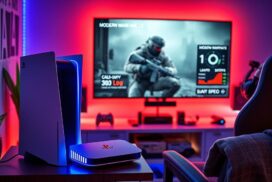Fixing PS5 Remote Play Connectivity Issues
To ensure a seamless gaming experience when using PS5 Remote Play, it’s important to troubleshoot and resolve any connectivity issues. This guide will provide step-by-step instructions and helpful tips to fix common problems that may arise during remote play.
PS5 Remote Play Setup and Requirements
Before troubleshooting any connectivity issues, it is necessary to ensure that your PS5 console and network are set up correctly for remote play. Follow the step-by-step instructions below to ensure a smooth setup process.
Enabling Remote Play
To enable PS5 Remote Play, follow these steps:
- Turn on your PS5 console and sign in to your PlayStation Network account.
- Navigate to “Settings” on the home screen.
- Select “System” and then choose “Remote Play”.
- Toggle the “Enable Remote Play” option to the on position.
Updating System Software
Keeping your PS5 console’s system software up to date is crucial for a seamless remote play experience. Here’s how to update the system software:
- Connect your PS5 console to the internet.
- Navigate to “Settings” on the home screen.
- Select “System” and then choose “System Software”.
- Select “System Software Update and Settings”.
- Choose “Update System Software” and follow the on-screen instructions to complete the update.
Checking Network Connection Speed
To ensure a stable remote play experience, it is essential to have a reliable network connection. Follow these steps to check your network connection speed:
- Go to the PS5 console’s home screen.
- Navigate to “Settings” and select “Network”.
- Choose “Connection Status” and note down the upload and download speeds.
For optimal performance, the minimum required connection speed for PS5 Remote Play is 5Mbps for both upload and download.
System Requirements for PS5 Remote Play
In addition to the setup process, make sure your devices meet the following requirements for PS5 Remote Play:
| Device | Requirement |
|---|---|
| PS5 Console | A PS5 console with the latest system software installed. |
| Controller | A DualSense wireless controller or DualShock 4 wireless controller. |
| Device for Remote Play | A compatible device such as a PC, Mac, iPhone, iPad, or Android smartphone or tablet. |
| Network Connection | A stable internet connection with a minimum upload and download speed of 5Mbps. |
Now that you have successfully set up your PS5 console and checked the requirements for remote play, you are ready to troubleshoot any connectivity issues that may arise. In the next section, we will discuss common PS5 Remote Play issues and provide detailed troubleshooting steps to resolve them.
Troubleshooting Common PS5 Remote Play Issues
When using PS5 Remote Play, you may encounter several common issues that can hinder your gaming experience. Understanding how to troubleshoot these problems is essential for a seamless gameplay session. This section provides specific troubleshooting steps for each problem, including the inability to connect to the console, an unstable connection, and a blank screen on the device. By following these steps, you can quickly resolve these issues and get back to enjoying your favorite games.
Troubleshooting the Inability to Connect to the Console
If you are unable to connect your device to the PS5 console for Remote Play, try the following troubleshooting steps:
- Ensure that your PS5 console is turned on and connected to the same network as your device.
- Check your network settings on both your device and the PS5 console to confirm they are properly configured.
- If you are using a wireless connection, move closer to your router to improve signal strength.
- Restart your device and the PS5 console, then attempt to connect again.
Troubleshooting an Unstable Connection
If you are experiencing an unstable connection while using PS5 Remote Play, follow these troubleshooting steps:
- Ensure that your internet connection is stable and that no other devices are heavily using the network.
- Consider using a wired Ethernet connection instead of Wi-Fi for a more stable connection.
- Adjust the video quality settings in the Remote Play application to reduce bandwidth usage.
- Restart your device and the PS5 console, then attempt to connect again.
Troubleshooting a Blank Screen on the Device
If you are encountering a blank screen on your device when using PS5 Remote Play, try the following troubleshooting steps:
- Adjust the video quality settings in the Remote Play application to ensure compatibility with your device’s screen resolution.
- Update the PS Remote Play application to the latest version to fix any known issues.
- Reinstall the Remote Play application on your device to ensure a clean installation.
- Verify that your device meets the minimum system requirements for PS5 Remote Play.
By following these troubleshooting steps, you can effectively address common PS5 Remote Play issues and enjoy a smooth gaming experience. If the problems persist, consider reaching out to PlayStation support for further assistance.
Dealing with Network Restrictions and Firewall Issues
When using PS5 Remote Play, it is important to be aware of certain network restrictions and firewall settings that may impact your gaming experience. Understanding and modifying these settings can help ensure a smooth and uninterrupted remote play session.
Network Restrictions:
PS5 Remote Play may be affected by specific network restrictions such as:
- Broadcasting from the console
- Launching unsupported games
- Using media apps simultaneously
It is recommended to check these settings on your console and make the necessary adjustments to ensure optimal performance while using Remote Play.
Firewall Settings:
Firewall software, including antivirus software, can sometimes interfere with PS5 Remote Play. If you are experiencing connectivity issues, it is advisable to:
- Temporarily disable the firewall or antivirus software on your device
- Add PS5 Remote Play to the list of allowed applications or exceptions in the firewall settings
- Ensure that any security software or parental controls are not blocking the Remote Play connection
By taking these steps, you can help prevent your antivirus software from blocking the Remote Play application and maintain a stable connection to your PS5 console.
For detailed instructions on checking and modifying network restrictions and firewall settings for PS5 Remote Play, refer to the manufacturer’s documentation or online support resources.
Network Restrictions and Firewall Settings
| Issue | Potential Impact | Solution |
|---|---|---|
| Broadcasting from the console | Unstable connection or lag during gameplay | Disable broadcasting feature or adjust streaming settings |
| Launching unsupported games | Inability to play certain games remotely | Ensure compatibility with Remote Play and update game software |
| Using media apps simultaneously | Decreased bandwidth availability for Remote Play | Close or pause media apps during remote play sessions |
| Firewall blocking Remote Play | Inability to connect or frequent disconnections | Temporarily disable the firewall or add exception for Remote Play |
By addressing network restrictions and firewall settings, you can optimize your PS5 Remote Play experience and enjoy seamless gaming sessions from any compatible device.
Enhancing PS5 Remote Play Connection Stability
To enhance the stability of your PS5 Remote Play connection and improve the streaming quality, there are several steps you can take. By implementing these measures, you can reduce latency for Remote Play and enjoy a smoother gaming experience.
1. Use a Wired Ethernet Connection
Instead of relying on Wi-Fi, connect your PS5 console to your router with an Ethernet cable. This can help improve connectivity and reduce interference, resulting in a more stable Remote Play connection.
2. Test Network Speed
Before initiating Remote Play, it’s essential to ensure that your network speed meets the recommended requirements. Use an online network speed test tool to assess your upload and download speeds. If the results are below 5Mbps, consider upgrading your internet plan or troubleshooting your network for better performance.
3. Lower Video Quality Settings
Adjusting the video quality settings can help optimize your Remote Play streaming experience. Lowering the video quality can reduce the strain on your network connection, resulting in smoother gameplay. Navigate to the Remote Play settings on your PS5 console and adjust the video quality to a lower resolution, such as 720p, if you experience latency or stability issues.
4. Minimize Bandwidth Usage
Bandwidth-intensive activities, such as streaming high-definition videos or downloading large files, can negatively impact your Remote Play connection. To reduce latency, temporarily pause or limit these activities while using Remote Play. Additionally, ensure that other devices connected to your network are not consuming excessive bandwidth, as this can affect the stability of your connection.
Implementing these measures can significantly enhance the stability of your PS5 Remote Play connection, improve streaming quality, and reduce latency. By utilizing a wired Ethernet connection, testing network speed, adjusting video quality settings, and minimizing bandwidth usage, you can optimize your overall gaming experience and enjoy uninterrupted gameplay.
Troubleshooting PS5 Remote Play on Mobile Data
When using PS5 Remote Play on mobile data, you may encounter issues such as unstable connections and poor video quality. This section provides troubleshooting steps specifically for mobile data usage, including finding stable locations with sufficient connection, avoiding switching between mobile data and Wi-Fi, and understanding potential limitations imposed by your mobile carrier.
1. Find Stable Locations with Sufficient Connection
When using PS5 Remote Play on mobile data, it’s essential to find areas with strong network coverage. Some locations may have weaker signals, resulting in unstable connections. To improve stability:
- Stay outdoors or near windows to ensure a better signal reception.
- Avoid crowded areas where network congestion is common.
- Consider using a mobile data booster or signal amplifier for better reception.
2. Avoid Switching Between Mobile Data and Wi-Fi
Switching between mobile data and Wi-Fi during a PS5 Remote Play session can cause disruptions and lead to unstable connections. To prevent this issue:
- Disable automatic Wi-Fi switching on your mobile device.
- Prioritize the use of either mobile data or Wi-Fi for a consistent connection.
3. Understand Potential Limitations Imposed by Your Mobile Carrier
Some mobile carriers may impose limitations on data usage, including restrictions on tethering or data caps. These limitations can affect the performance of PS5 Remote Play on mobile data. To avoid issues:
- Check your mobile carrier’s terms and conditions regarding tethering and data usage.
- Monitor your mobile data usage to stay within the allowed limits.
- Consider upgrading your data plan if needed.
By following these troubleshooting steps, you can enhance your PS5 Remote Play experience on mobile data and overcome issues such as unstable connections and poor video quality.
| Error Code | Description | Possible Solution |
|---|---|---|
| RP-001 | Connection Error | Check your mobile data signal strength and try reconnecting. |
| RP-002 | Video Quality Issues | Move to an area with better network coverage or adjust video quality settings. |
| RP-003 | Network Congestion | Try connecting at a different time when network traffic is lower. |
Conclusion
Ensuring a seamless gaming experience with PS5 Remote Play requires addressing any connectivity issues that may arise. By following the troubleshooting steps provided in this guide, you can effectively overcome common problems and optimize your remote play connection.
It is important to regularly update the PS Remote Play application to take advantage of the latest enhancements and bug fixes. Additionally, consulting your internet service provider can help resolve any network-related issues that may affect your remote play experience.
With PS5 Remote Play, you can enjoy uninterrupted gaming from anywhere, whether it’s in the comfort of your home or on the go. Stay connected and immerse yourself in your favorite games without limitations. Explore the vast possibilities of PS5 Remote Play and elevate your gaming experience.
FAQ
What are the common connectivity issues when using PS5 Remote Play?
The common connectivity issues when using PS5 Remote Play include the inability to connect to the console, unstable connection, and a blank screen on the device.
How can I troubleshoot these connectivity issues?
To troubleshoot these connectivity issues, you can check your network settings, reinstall the Remote Play application, and adjust video quality settings.
What restrictions and firewall settings can interfere with PS5 Remote Play?
Broadcasting from the console, launching unsupported games, and using media apps simultaneously can interfere with PS5 Remote Play. Additionally, anti-virus software on your device may block Remote Play.
How can I deal with these restrictions and firewall issues?
To deal with these restrictions and firewall issues, you can check and modify the settings accordingly.
How can I enhance the stability of my PS5 Remote Play connection?
You can enhance the stability of your PS5 Remote Play connection by using a wired Ethernet connection instead of Wi-Fi, testing network speed, lowering video quality settings, and minimizing bandwidth usage from other devices on your network.
What troubleshooting steps should I take when using PS5 Remote Play on mobile data?
When using PS5 Remote Play on mobile data, you should find stable locations with sufficient connection, avoid switching between mobile data and Wi-Fi, and understand potential limitations imposed by your mobile carrier.
How can I fix PS5 Remote Play connectivity issues?
To fix PS5 Remote Play connectivity issues, you should follow the troubleshooting steps outlined in this guide, regularly update the PS Remote Play application, and consult your internet service provider for any network-related issues.












